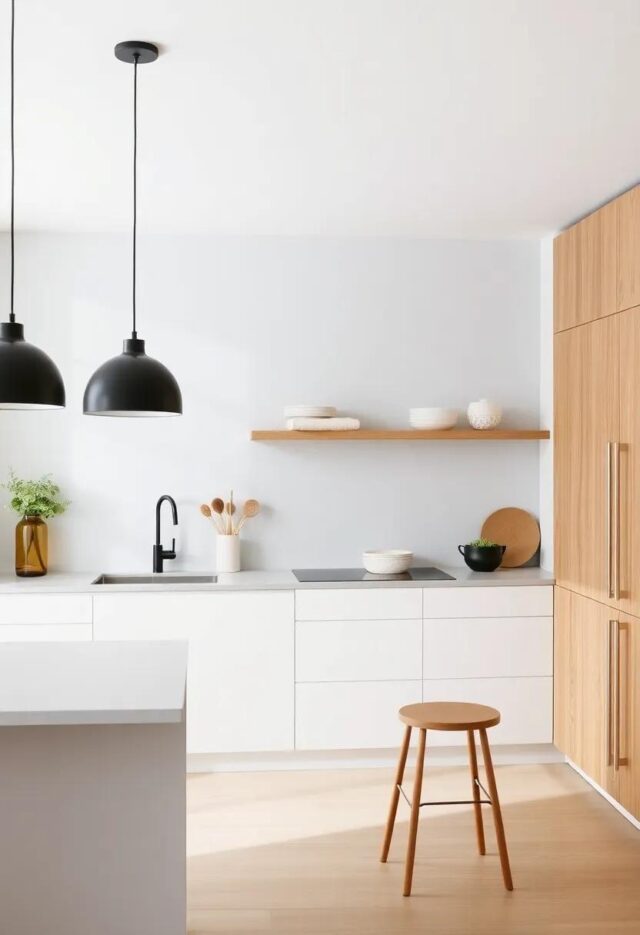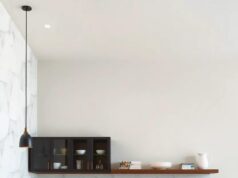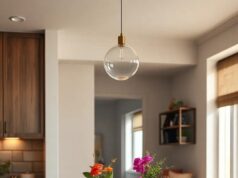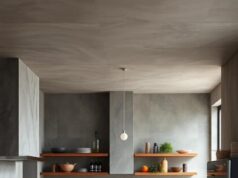in a world frequently enough overwhelmed by chaos and clutter,the Scandinavian approach to design offers a refreshing respite that champions simplicity and functionality. Rooted in a philosophy that celebrates minimalism, warmth, and practicality, Scandinavian kitchen interior design has captured the hearts of many who seek spaces that evoke serenity while remaining highly livable. This article delves into the charm and allure of Scandinavian kitchens, exploring how their clean lines, muted palettes, and thoughtful institution create an inviting atmosphere that transforms the heart of the home. Join us as we navigate the key elements that define this aesthetic,uncovering how embracing simplicity can enhance not just the beauty of our kitchens,but also our everyday lives.
Embracing Natural Light to Enhance Scandinavian Kitchen Aesthetics
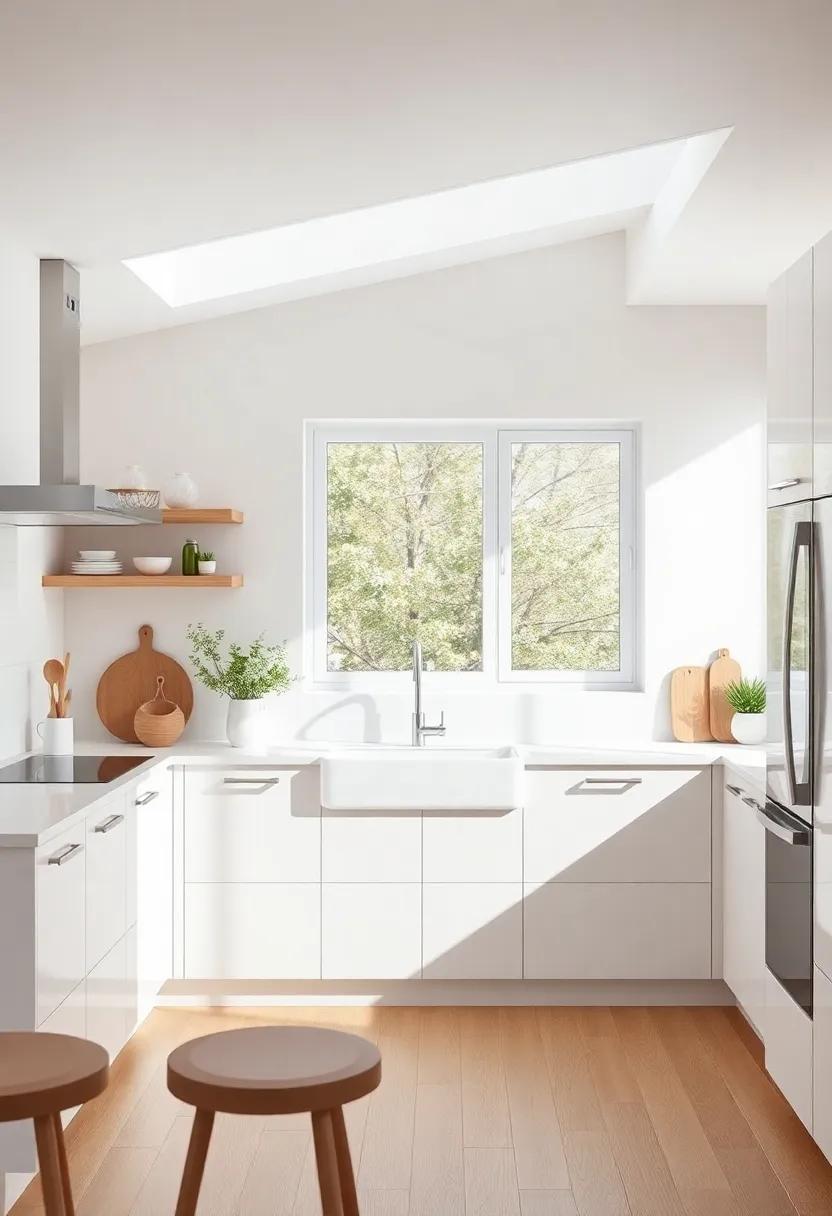
In Scandinavian kitchen design, the use of natural light is paramount for creating a serene and inviting space. Large windows that flood the room with sunlight not only enhance the aesthetic but also promote a sense of openness and connection to nature. This emphasis on light can be further accentuated by incorporating light-colored surfaces, such as white cabinetry and soft wood accents, which reflect and amplify the sunlight cascading through the windows. By strategically placing mirrors or shiny materials, the brightness can be maximized, creating an airy feel that is both functional and beautiful.
To complement the influx of natural light, consider utilizing a palette of muted tones and organic materials that resonate with the simplicity of Scandinavian design. Elements such as natural wood floors, ceramic tiles, and linen curtains can enhance the warmth of the sunlight, while still maintaining a clean and minimalist vibe.Here are some key points to remember when designing with light:
- Open Layouts: Encourage flow between spaces to maximize daylight.
- Light Fixtures: Use simple yet elegant lighting to maintain continuity after sunset.
- Indoor Plants: Incorporate greenery that thrives on natural light for a fresh aesthetic.
minimalist Lines and Functional Design: The Hallmarks of scandinavian Kitchens
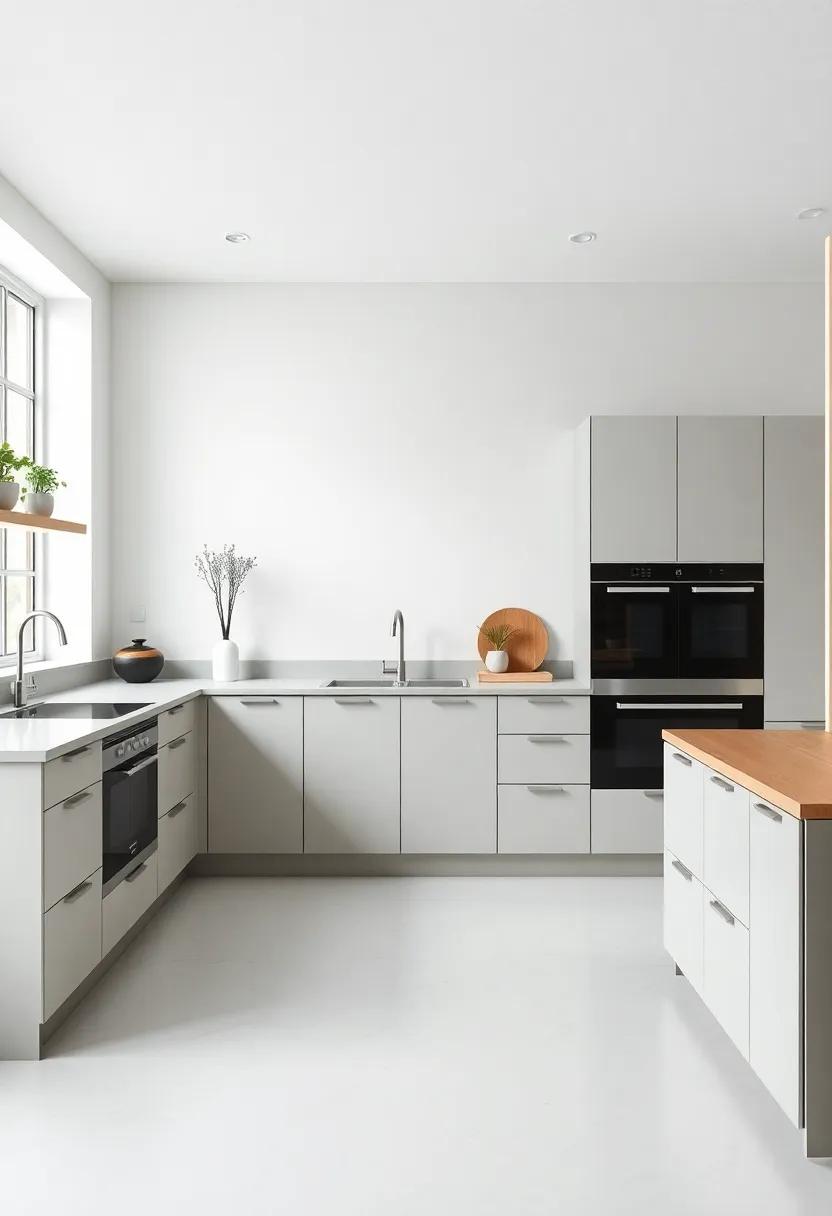
Scandinavian kitchens are a testament to the beauty of simplicity and functionality. Characterized by clean lines and an uncluttered aesthetic, these spaces prioritize both form and function, ensuring that every element serves a purpose. Sleek cabinetry in light woods or whites creates a harmonious backdrop, while natural light floods the room, enhancing the spacious feel typical of Scandinavian design. Key design elements include:
- Natural materials: Wood, stone, and metal are favored for their warmth and durability.
- Neutral color palettes: Whites, greys, and earthy tones provide a serene environment.
- Open layouts: Promoting a fluid transition between cooking, dining, and living areas.
Functionality is integral to scandinavian design, ensuring that kitchens are not only visually appealing but also highly efficient. Thoughtful organization through innovative storage solutions allows for a clutter-free environment, which embodies the Scandinavian ethos of minimalism. even kitchen accessories are chosen for their simplicity and utility, often doubling as decor. The following table summarizes key attributes of Scandinavian kitchen design:
| Attribute | Description |
|---|---|
| Light-Filled | Maximizes natural light to enhance the sense of space. |
| Sustainable Practices | Focus on eco-friendly materials and energy-efficient appliances. |
| Functional Layouts | Ensures ease of use and access to essentials. |
Incorporating Earthy Tones: Color Palettes for a Harmonious Kitchen Space
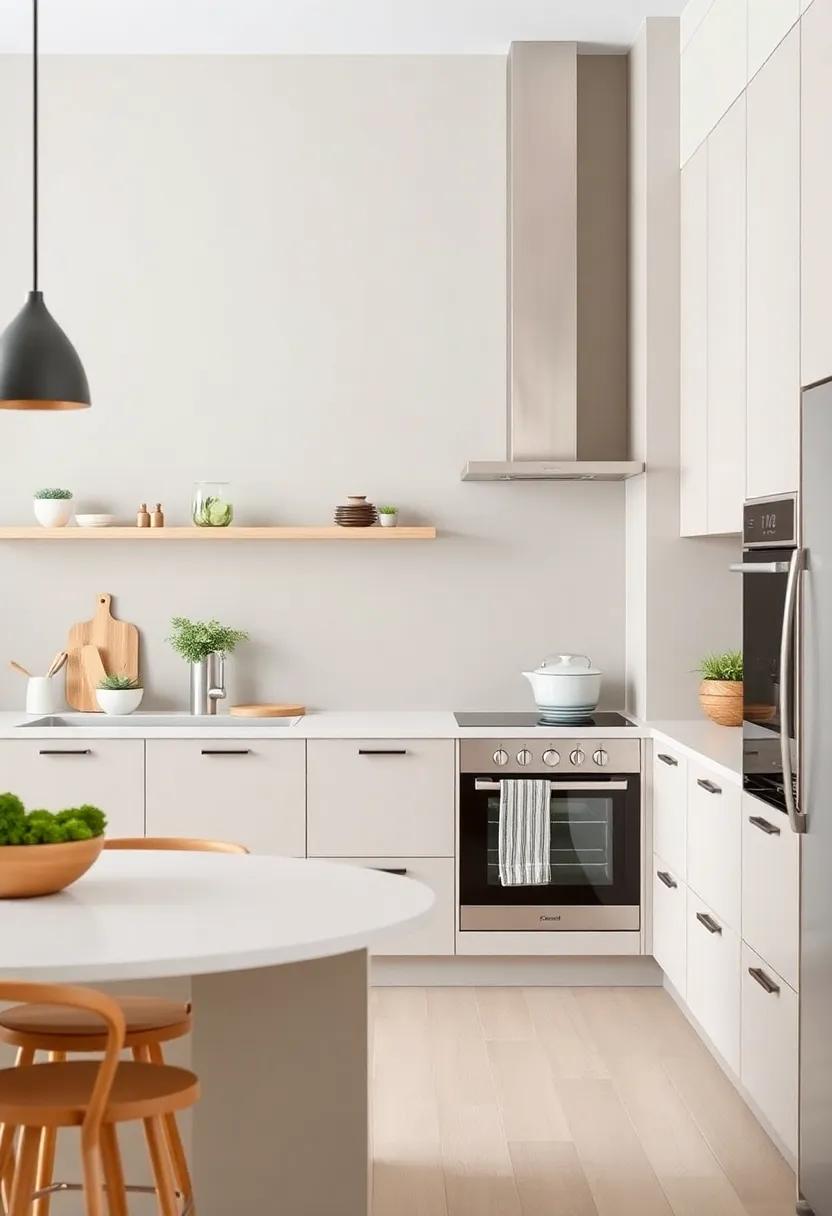
In a Scandinavian kitchen, earthy tones create a tranquil and inviting atmosphere, effortlessly blending aesthetics with functionality. Employing a rich tapestry of colors inspired by nature can evoke warmth and serenity, fostering a cozy space for cooking and gathering. Consider incorporating hues such as warm beige, soft greys, earthy browns, and subtle olive greens to establish a grounded palette. This integration of color can be realized through cabinetry, countertops, and accents, thus transforming a mundane kitchen into a harmonious retreat where simplicity reigns.
To refine the earthy palette, you might explore accent tones that build upon the base colors while adding depth and dimension. A splash of deep terracotta or dusty blue can offer striking focal points without overwhelming the senses. It’s also essential to balance natural materials, such as wood and stone, with these colors, grounding the design in a tactile experience. Here are some effective accent ideas to consider:
- Textiles: Soft linens in muted tones for curtains and table settings.
- Wall art: Natural landscape photography or abstract pieces that feature earthy colors.
- Plants: Incorporate greenery with ceramic pots that harmonize with your color scheme.
Sustainable Materials: The Eco-Friendly Choice for Scandinavian Interiors
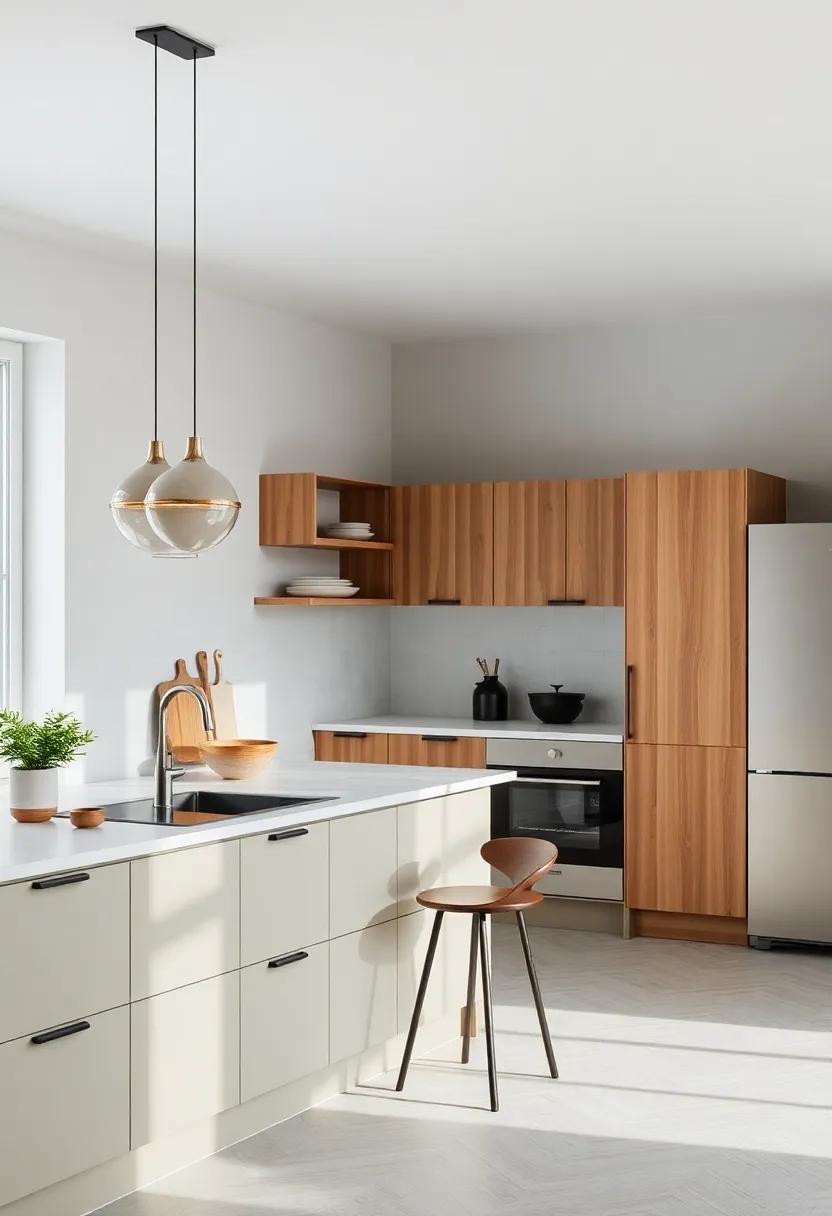
In the realm of Scandinavian interiors, where minimalism meets functionality, the choice of materials plays a pivotal role in creating an inviting space. Natural woods, bamboo, and recycled textiles dominate the scene, offering not only aesthetic appeal but also environmental benefits. By opting for sustainable materials, designers and homeowners alike contribute to reducing environmental impact without sacrificing style. The use of non-toxic finishes and low-VOC paints further enhances the health of indoor environments, providing peace of mind for those seeking a harmonious home. This commitment to eco-friendliness aligns perfectly with the Scandinavian ethos of simplicity and respect for nature.
Among the most popular choices are reclaimed wood and bamboo, both known for their durability and low ecological footprint. Options like cork and hemp are also gaining traction, valued for their unique textures and renewable properties. When selecting materials, consider the following attributes that resonate with a sustainable lifestyle:
- Renewability: Look for materials that regenerate naturally and rapidly.
- Local Sourcing: Reduce carbon footprints by choosing locally produced options.
- Longevity: Invest in materials that withstand the test of time and trends.
- recyclability: Opt for items that can be repurposed or recycled at their end of life.
Open Layouts: The Essence of Space in Scandinavian Kitchen Design
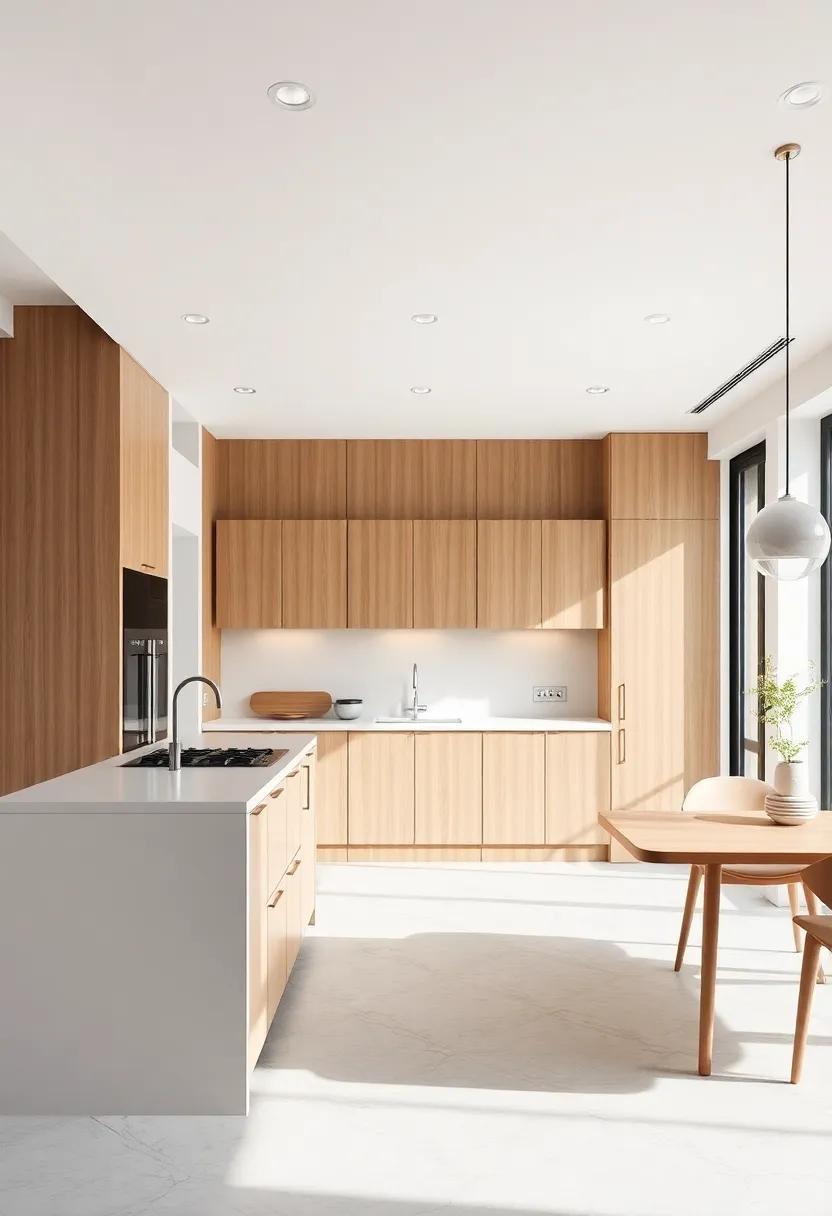
Open layouts are the heart of Scandinavian kitchen design, allowing for a seamless flow between cooking, dining, and socializing. This interconnected approach not only enhances functionality but also invites natural light to permeate the space, creating an airy, spacious atmosphere. Key elements of this design philosophy include:
- Minimalist Aesthetic: Fewer partitions result in fewer distractions, allowing the beauty of essential items to shine.
- Natural Materials: Wood and stone elements bring the warmth of nature indoors, enhancing the sense of openness.
- Unified Color Palettes: soft, muted tones create a harmonious backdrop that feels expansive and soothing.
The use of multifunctional furniture is another hallmark of these designs. Islands serve as cooking stations, dining areas, and gathering spots, maximizing every square inch while minimizing clutter. This versatility is complemented by thoughtfully curated storage solutions that keep the space organized and inviting. A concise overview of features often found in these kitchens reveals a calculated approach to design:
| Feature | Description |
|---|---|
| Open Shelving | Encourages displays of everyday items, promoting ease of access and personal touch. |
| Large Windows | Utilizes natural light to enhance the feeling of openness. |
| Neutral Tones | Creates a calm, cohesive look that is easy to decorate and maintain. |
Textured Surfaces: Adding Depth to Minimalist Scandinavian Kitchens
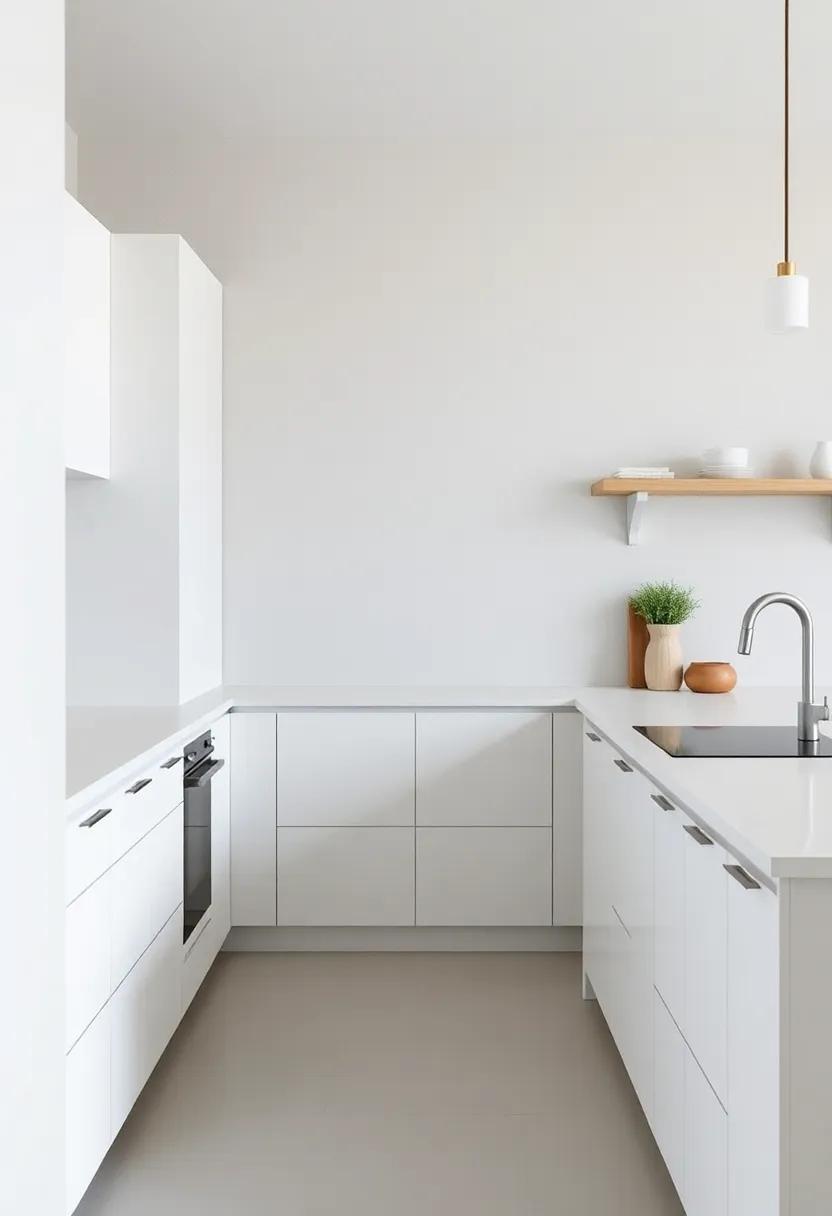
In the realm of minimalist Scandinavian kitchens, the appeal of textured surfaces is undeniable. These tactile elements invite a casual yet elegant vibe, breaking the monotony often associated with simplicity. Incorporating natural materials such as wood, stone, and ceramic can create warmth, while strategically placed textiles add softness. For instance, a rough-hewn wooden countertop can contrast beautifully with sleek stainless steel appliances, establishing a harmony between raw and refined. This juxtaposition not only adds visual intrigue but also enhances the overall sensory experience of the kitchen.
Consider integrating a variety of textures through thoughtful design choices. A few ideas include:
- handcrafted Tiles: Use artisanal tiles on backsplashes or floors to introduce unique patterns.
- Textured Wall Finishes: Clay or plaster finishes can impart an earthy feel to the space.
- Layered Fabrics: Incorporate linen or cotton for curtains and table linens to soften hard surfaces.
By layering these elements, each texture contributes to a cohesive design narrative, creating a kitchen that feels both functional and inviting. The presence of diverse materials not only reinforces the Scandinavian ethos of embracing nature but also cultivates a unique atmosphere, where the simplicity of design is enhanced by the richness of tactile experience.
Crafting a Cozy Atmosphere with Scandinavian Kitchen Accessories
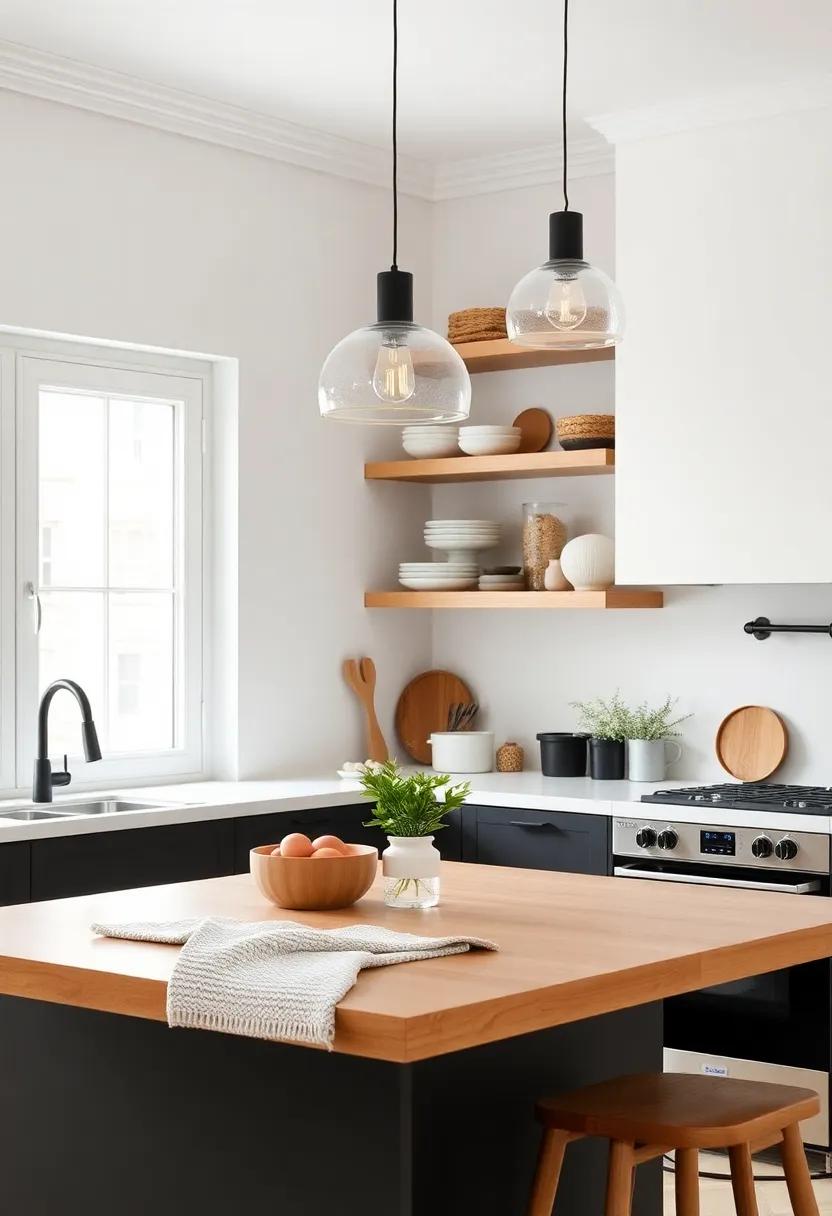
Creating a warm and inviting kitchen space is essential for both functionality and comfort. Scandinavian kitchen accessories excel in enhancing the cozy atmosphere, focusing on functionality while staying true to minimalist aesthetics. With a thoughtful selection of accessories, one can transform a simple kitchen into a sanctuary. materials such as wood, ceramics, and textiles play a vital role, bringing natural elements indoors. Consider incorporating:
- Handcrafted wooden utensils that not only serve a purpose but also add a touch of natural beauty.
- Soft cotton or linen dishcloths for a gentle touch and a burst of color.
- Elegant ceramic dishes that reflect the simplicity and elegance of scandinavian design.
To achieve that sought-after snug effect, layering is key. Mixing textures and colors while maintaining a cohesive palette can create depth without overwhelming the senses. Soft-edged lighting is crucial in setting the ambiance; think of pendant lights above your island or warm LED strips under cabinets. Additionally, a well-placed table can serve as a centerpiece for gatherings. Here’s a swift look at essential elements to consider when choosing your accessories:
| Accessory Type | Material | Purpose |
|---|---|---|
| Cutting Boards | wood | Practical & Decorative |
| Serving Platters | Ceramic | Display & Serve |
| Textiles | Cotton/Linen | Comfort & Warmth |
innovative Storage Solutions for a Clutter-Free Scandinavian Kitchen
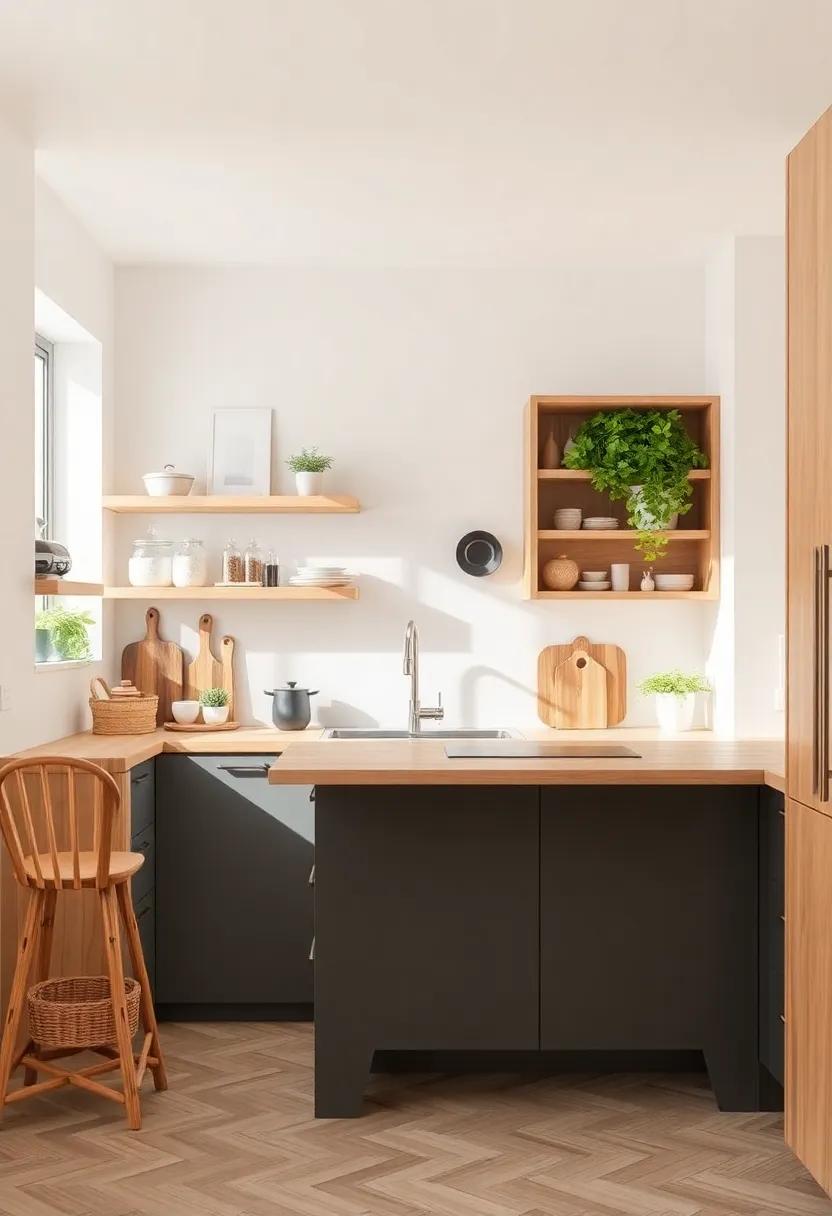
Transform your kitchen into a haven of cleanliness and efficiency with clever storage innovations that cater to both functionality and aesthetic appeal. Scandinavian design thrives on minimalism, and implementing open shelving can make the space feel airy while providing easy access to everyday essentials. Consider a combination of:
- Wall-mounted racks for pots and pans
- Slide-out pantry drawers that maximize corner space
- Magnetic strips for holding knives and utensils
Using these features not only saves space but also allows for a more streamlined look that is quintessentially Scandinavian.
For a more personalized touch, integrate multi-functional furniture that serves double duty, like a kitchen island with built-in cabinets. This not only offers additional storage but also creates a central hub for meal prep and casual gatherings. to further enhance organization, utilize clear containers and labeled baskets in your drawers and cupboards. The following table illustrates some essential storage ideas to keep your kitchen tidy:
| Storage Type | Benefits |
|---|---|
| Vertical Cabinets | Maximize space by taking advantage of height |
| Hanging Herb Gardens | Add greenery while saving counter space |
| Drawer Organizers | Keep utensils and tools neatly arranged |
The importance of Wood Elements in Scandinavian Kitchen Design
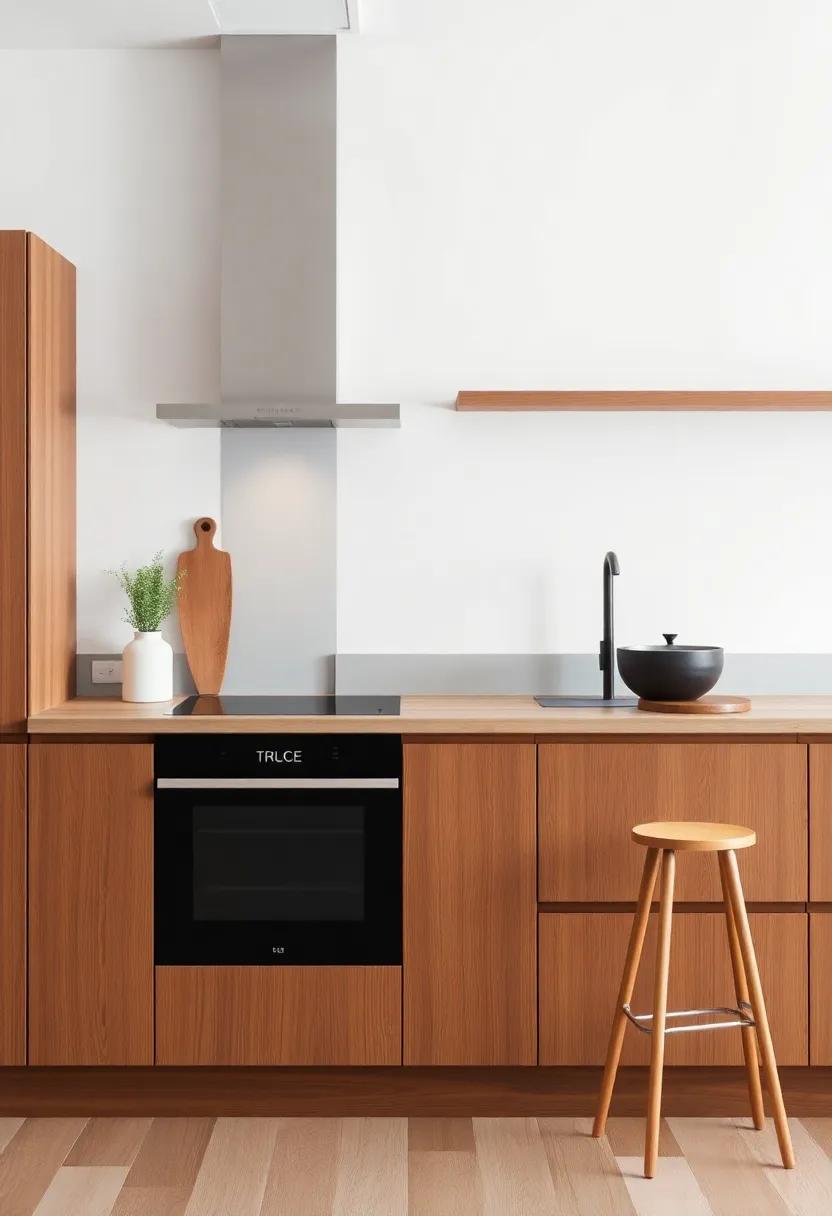
Wood elements play a pivotal role in creating the quintessential Scandinavian kitchen, serving not only as a design choice but also as an embodiment of the region’s values. The warmth of natural wood resonates with the minimalist philosophy, fostering an atmosphere that feels both inviting and serene. Incorporating materials such as oak, birch, or pine contributes to the overall aesthetic while also promoting sustainability—reflecting a deep respect for nature that characterizes Scandinavian design.By using wood for cabinetry,countertops,or decorative accents,kitchens can achieve a balance between functionality and beauty,creating spaces that are practical yet refined.
The strategic use of wood can also enhance the kitchen’s functionality. Many Scandinavian kitchens incorporate open shelving made from reclaimed wood, which not only showcases beautiful dishware but also adds a rustic charm. The following features highlight the meaning of wood in this design approach:
- Textural Contrast: Wood brings warmth against cooler materials like steel and glass.
- Versatile Styles: Ranging from contemporary chic to farmhouse rustic, wood can adapt to any personal taste.
- Eco-Friendly Choices: Sustainable sourcing of wood supports environmental efforts and promotes eco-conscious living.
additionally, when curated carefully, different wood tones can create a cohesive flow throughout the kitchen, enhancing visual interest while maintaining a sense of unity.
Balancing Form and Function: Scandinavian Kitchen Essentials
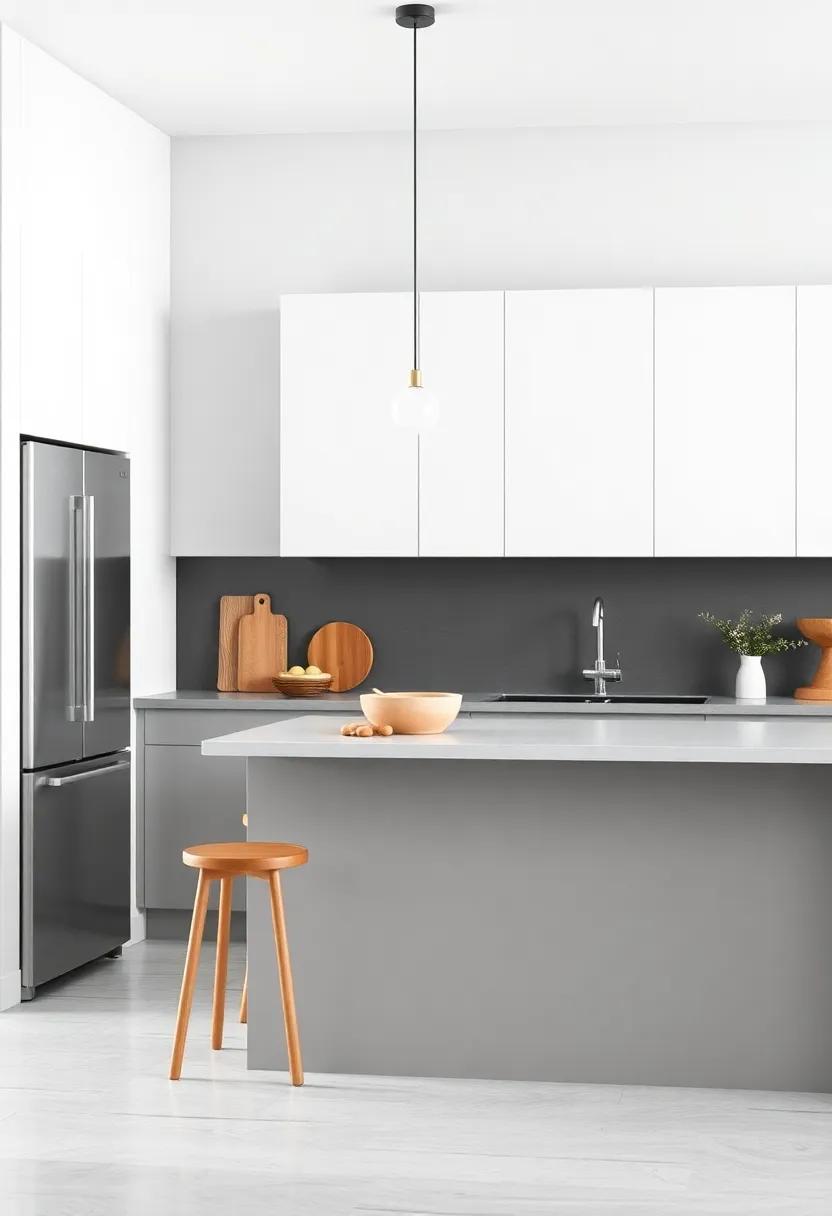
In Scandinavian design, the kitchen serves not just as a cooking area but as the heart of the home, combining minimalist aesthetics with practical functionality. To achieve this balance, it’s essential to curate a selection of kitchen essentials that emphasize both style and usability. Natural materials like wood and stone are predominant, bringing in warmth and simplicity. Key items often include:
- Open shelving: Showcases beautiful dishware while keeping everything accessible.
- Multi-functional furniture: A kitchen island that doubles as a dining space or a prep station.
- Neutral color palettes: Soft whites,muted grays,and pastel hues that create a calming environment.
moreover, the integration of modern technology in a discreet manner adds to the appeal of a Scandinavian kitchen. Appliances are chosen not only for their functionality but also for their design, ensuring they blend seamlessly into the overall aesthetic. Below is a concise overview of commonly favored appliances:
| Appliance | Feature |
|---|---|
| Integrated Fridge | Streamlined design that hides away essentials |
| Induction Cooktop | Efficient and sleek with instant heat |
| Smart Oven | Wi-Fi enabled for remote control and convenience |
Bespoke Shelving Ideas for a Customized Scandinavian Kitchen Look
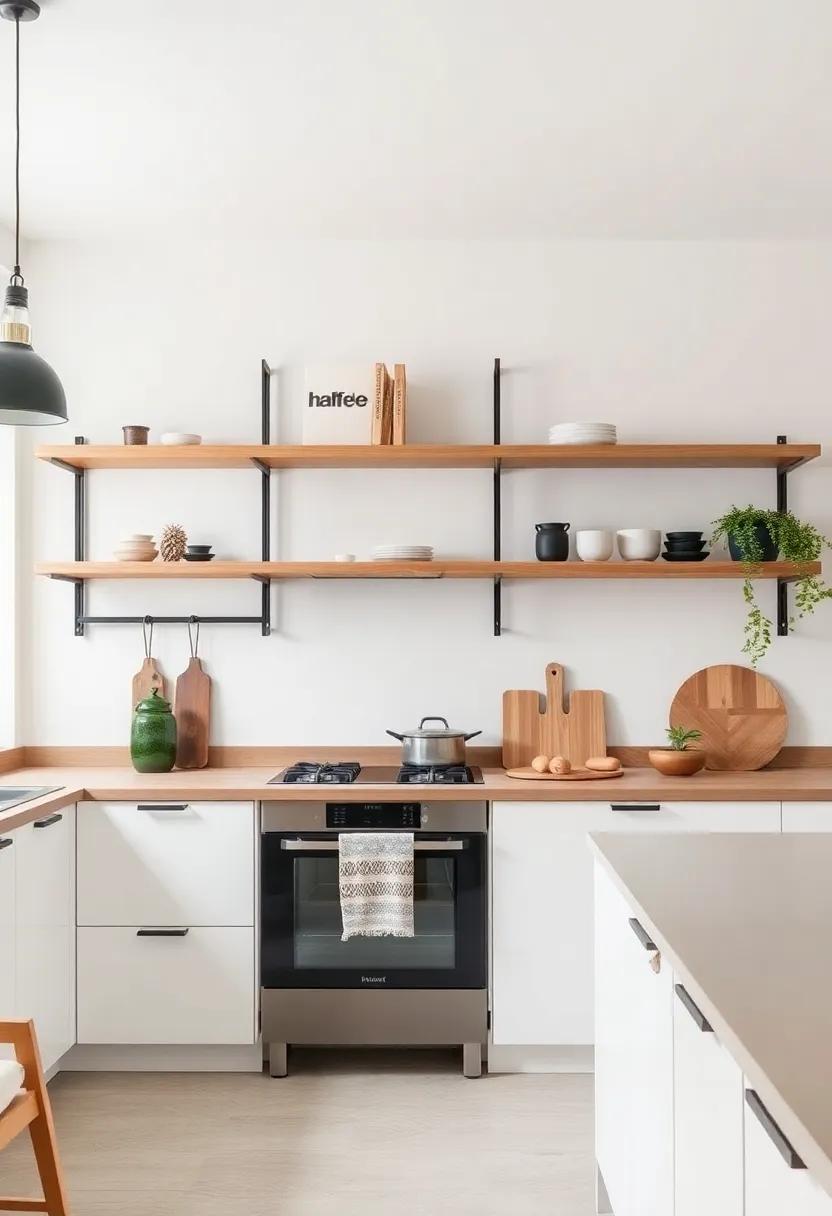
In Scandinavian kitchen design, bespoke shelving plays a pivotal role in achieving both functionality and aesthetic appeal. Custom shelving options not only maximize space but also serve as a canvas for personal expression. Consider incorporating open shelves crafted from natural wood to echo the rustic charm synonymous with Scandinavian design. Pair these shelves with minimalist brackets that blend seamlessly into the background, allowing your curated kitchenware to take centre stage. Here are a few ideas for styling:
- Layered Textures: Combine wooden shelves with metal accents for an industrial touch.
- Color Coordination: Use soft pastel containers and cookware that complement the light wood hues.
- smart Lighting: Install recessed lighting above or beneath shelves to create a warm, inviting atmosphere.
For those seeking a unique, personal touch, a custom shelving unit can be designed to fit into the nooks of your kitchen.This not only utilizes awkward spaces effectively but also showcases your favorite kitchen items in a tailored manner. Imagine an open pantry-style shelf, where jars of spices and snacks become part of the decor. utilizing a combination of horizontal and vertical shelving can further enhance dynamic visual interest:
| Style | Material | Best For |
|---|---|---|
| Floating Shelves | natural Wood | Displaying Cookbooks |
| Corner Shelves | Metal Frames | space-saving Storage |
| Grid Shelves | Glass Panels | Stylish Dish Storage |
Embracing Nature: Indoor Plants as a Key Component of Kitchen Design
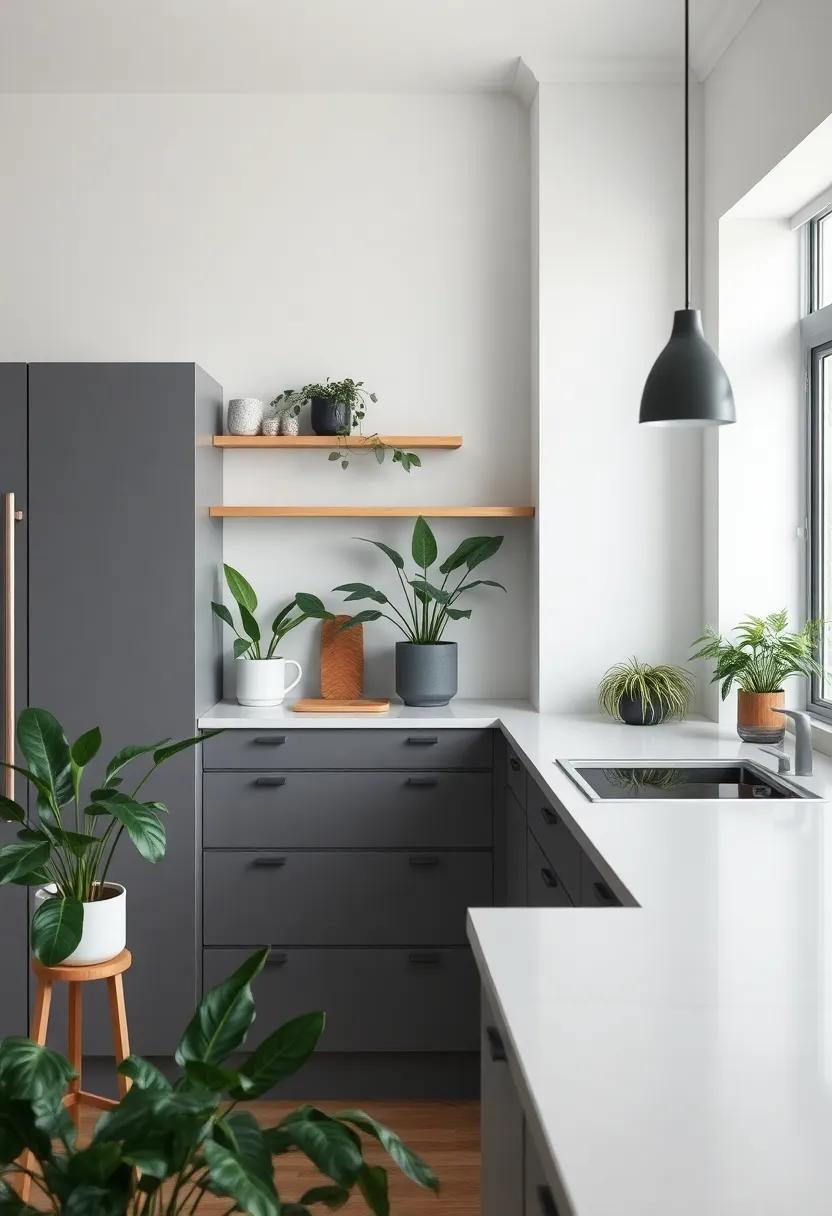
incorporating indoor plants into kitchen design not only enhances aesthetics but also contributes to a serene and inviting environment.Greenery serves as a natural air purifier, filtering toxins and increasing humidity, which is notably beneficial in kitchens where heat and moisture abound. When choosing plants, consider those that thrive in lower light conditions and require minimal maintenance, allowing you to enjoy the beauty of nature without added stress. A carefully arranged selection of herbs and foliage can elevate your culinary space, merging functionality with tranquility.
To integrate indoor plants seamlessly into your Scandinavian-inspired kitchen, consider the following options:
- Herbs: Fresh basil, mint, and rosemary not only enhance the decor but also provide fresh ingredients for cooking.
- Succulents: Low-maintenance and stylish, they add texture without overwhelming the space.
- Ferns: Their lush greenery softens hard surfaces, promoting a calming atmosphere.
Placing these plants on open shelves or hanging them above countertops can create a dynamic visual flow. Additionally, using simple yet elegant pots can reflect the minimalist ethos of Scandinavian design. Consider this mini-table for plant choices and their benefits:
| Plant Type | Benefits |
|---|---|
| Herbs | Fresh flavor, easy access for cooking |
| Succulents | Low maintenance, adds visual appeal |
| Ferns | Humidity boost, softens decor |
The Role of Art and Decor: Personalizing a scandinavian Kitchen Aesthetic
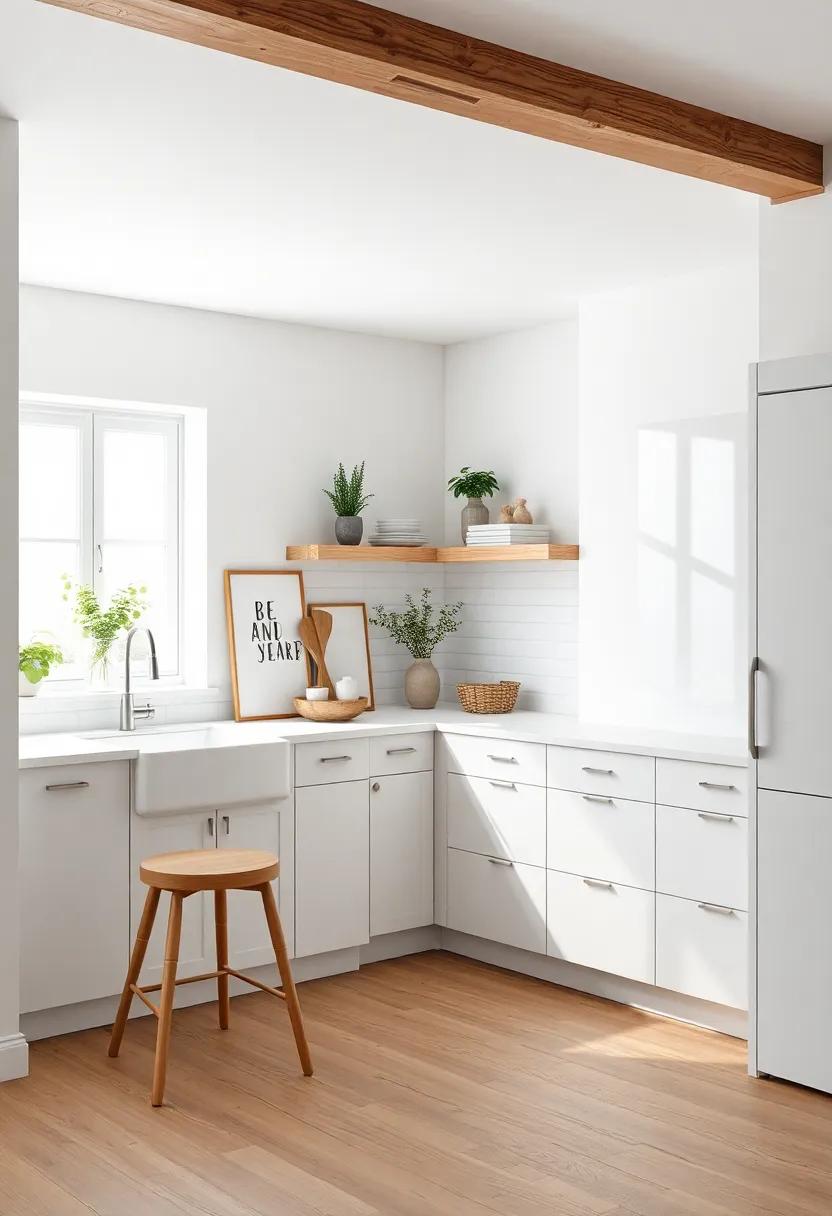
Incorporating art and decor into a Scandinavian kitchen transforms it from a simple cooking space to a personalized sanctuary.Thoughtfully selected pieces can express individual tastes while adhering to the minimalist ethos. Consider incorporating elements such as:
- Natural Artwork: Opt for framed botanical prints or landscape photography that echoes the serene Nordic surroundings.
- Handcrafted Ceramics: Display beautiful pottery or tableware that tells a story and adds a unique touch to the space.
- Warm Textiles: Incorporate woven rugs, linen curtains, or soft throws to soften the starkness frequently enough associated with minimalism.
Colors play a pivotal role in enhancing the aesthetic. earthy tones and muted pastels can create a cohesive and calming atmosphere. Pairing these shades with natural elements like wood and stone fosters a harmonious balance. A simple table can serve as an exquisite centerpiece, adorned with:
| item | Purpose |
|---|---|
| Fresh Herbs | Add life and fragrance to the kitchen. |
| Candles | Create a warm, inviting ambiance. |
| seasonal Decor | Reflect the changing seasons with subtle decorations. |
Cohesive Lighting Designs That Illuminate Scandinavian Kitchen Spaces
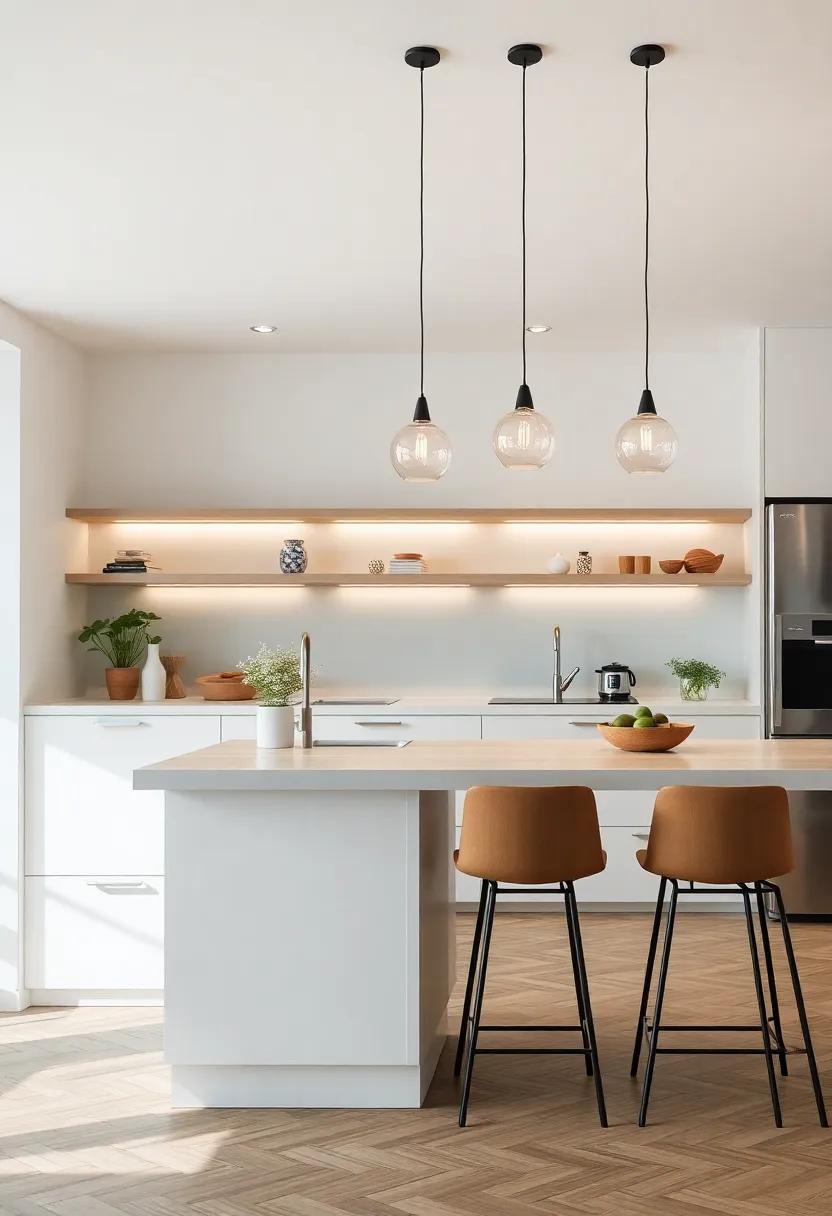
In the heart of Scandinavian design lies a profound understanding of how lighting can define a space, notably in kitchen environments. A cohesive lighting scheme goes beyond mere functionality; it enhances the minimalistic aesthetic that characterizes these interiors. The interplay of natural light with carefully chosen artificial sources creates a warm and inviting atmosphere, making the kitchen a vibrant hub of activity. Incorporating pendant lights,under-cabinet lighting,and recessed fixtures showcases the craftsmanship and design elements unique to Scandinavian style.
Consider these essential elements when crafting your lighting design:
- Natural Light Utilization: Large windows and open layouts maximize sunlight, creating a bright and airy feel.
- layered Lighting: Combine ambient, task, and accent lighting to achieve depth and functionality.
- Material Selection: Choose fixtures made from wood,metal,and glass to complement the organic hues typical of Scandinavian interiors.
- Adjustable Features: Dimmer switches and adjustable fixtures allow for versatility in setting the mood, from bright tasks to cozy gatherings.
| Lighting Type | Purpose |
|---|---|
| Pendant Lights | Focus on kitchen islands and dining areas. |
| Under-Cabinet Lighting | Enhance workspace visibility and ambiance. |
| Recessed Fixtures | Provide overall illumination and a seamless look. |
creating Inviting Gatherings: The Scandinavian Kitchen as a Social Hub
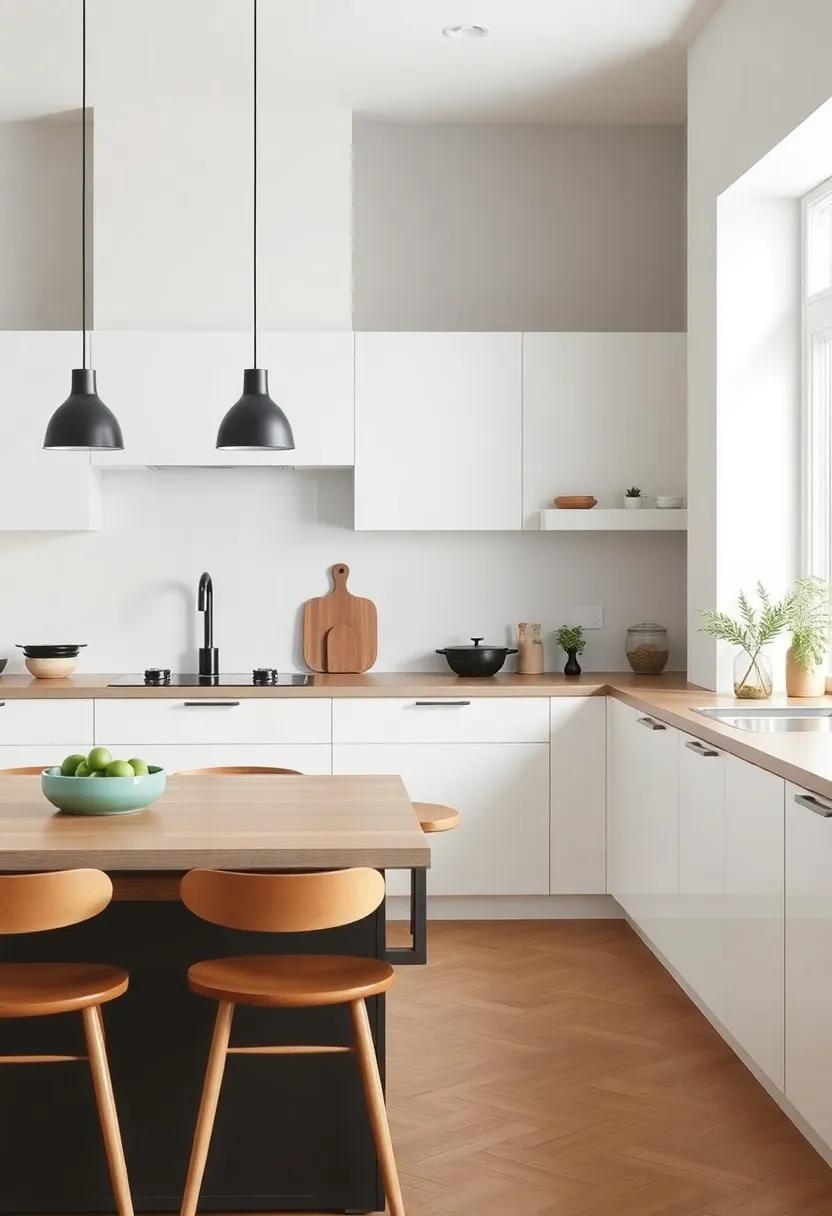
In a Scandinavian kitchen, the aesthetic is not merely about visual appeal; it embodies a philosophy of connection and community. This design approach encourages lively gatherings, where friends and family come together to share meals, stories, and laughter. Natural materials such as wood, stone, and soft textiles create an inviting atmosphere, making it easy to feel at home. Key elements that contribute to this welcoming vibe include:
- Open Layout: A spacious configuration promotes interaction and makes it easy to move around.
- Warm Lighting: Soft, ambient lighting fosters a cozy feel, perfect for evening dinners.
- Functional Furniture: Multi-purpose pieces, like a large dining table, can transition from meal prep to hosting.
The beauty of the Scandinavian kitchen is in its simplicity and functionality. the focus on decluttered spaces allows for more meaningful interactions, transforming cooking into a communal experience. Additionally, incorporating elements such as a herb garden or a shared cookbook station not only enhances accessibility but also fosters collaboration in meal preparation. Creating a nurturing environment,here are some essential features to consider when designing your space:
| Feature | Description |
|---|---|
| Large Island | Central hub for cooking and conversation. |
| Cozy Nooks | Inviting spots for casual hangs with coffee or desserts. |
| Earthy Tones | Colors that reflect nature to promote tranquility. |
Combining Modern and Traditional Elements in Scandinavian Style
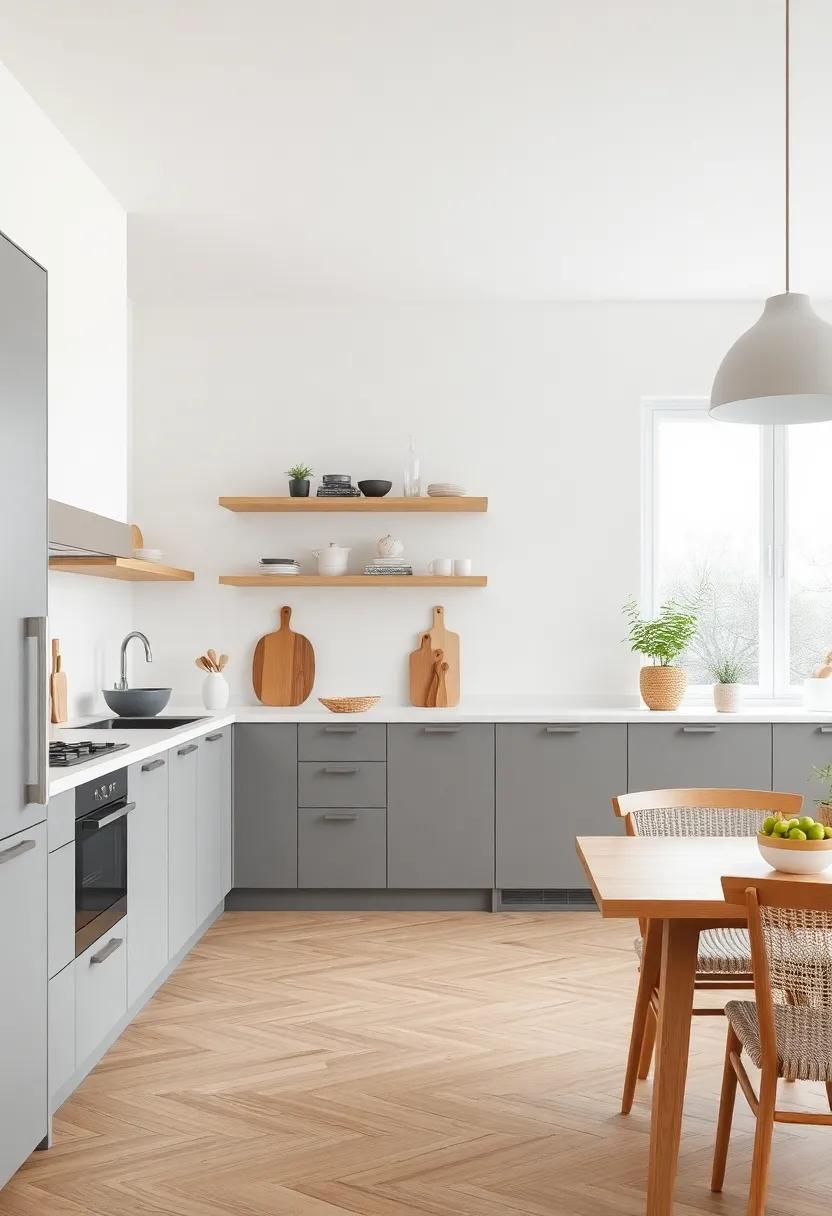
To achieve a harmonious blend of modern and traditional elements in Scandinavian kitchen design, focus on simplicity and functionality. Incorporate clean lines and minimalistic forms that characterize modern aesthetics, while weaving in traditional accents such as rustic wooden cabinetry or handcrafted pottery. These elements not only bring warmth and personality to the space but also tell a story, connecting the past with contemporary sensibilities. Consider using a neutral color palette that complements both styles, providing a backdrop that allows for subtle pops of color through textiles or decorative accessories.
The juxtaposition of sleek materials like stainless steel with the organic textures of natural wood creates a visually appealing contrast. A table showcasing various finishes can offer inspiration:
| Material | style Influence |
|---|---|
| Stainless Steel | Modern |
| Reclaimed Wood | Traditional |
| Cotton textiles | Modern/Traditional |
Enhance the connection between these styles by selecting decorative elements that serve both beauty and purpose. Such as, consider open shelving to display handcrafted items alongside sleek kitchen tools or mixing vintage tableware with contemporary designs. Such thoughtful combinations will create a space that feels both inviting and uniquely personal while maintaining the celebrated Scandinavian ethos of functional beauty.
Dressing Windows: choosing the Right Treatments for Scandinavian Kitchens
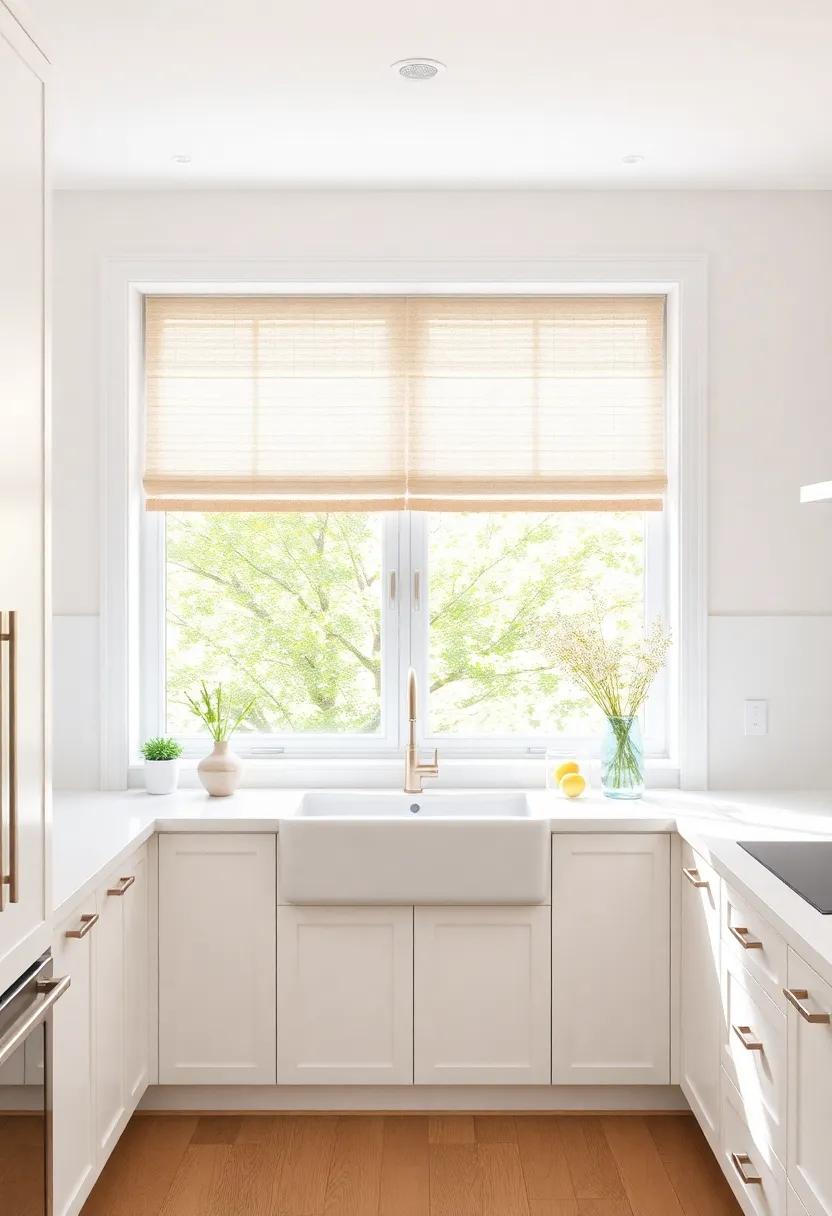
In Scandinavian kitchens, window treatments should enhance the overall minimalist aesthetic while allowing natural light to flow freely. Soft, sheer fabrics are ideal for maintaining an airy feel, providing privacy without obstructing sunlight. Consider selecting materials like linen or cotton in neutral colors that complement the light wood tones typically found in these spaces. Additionally, roller shades or Roman blinds offer a sleek look without overwhelming the design, and they can be easily retracted when more light is desired.
When choosing colors and patterns for window treatments, opt for subdued palettes that align with the Scandinavian ethos of simplicity.Geometric patterns or subtle textures can add visual interest while still adhering to the clean lines of the design. avoid heavy drapery that can detract from the light and uncluttered environment.here’s a quick look at treatment styles that work beautifully in Scandinavian kitchens:
| Window Treatment Style | Best For |
|---|---|
| Sheer Curtains | Natural light & soft aesthetics |
| Roller Shades | Modern, minimal look |
| Roman Blinds | Elegant and functional |
| Wooden Shutters | Timeless appeal & control |
Exploring Iconic Scandinavian Brands That Shape Kitchen Trends
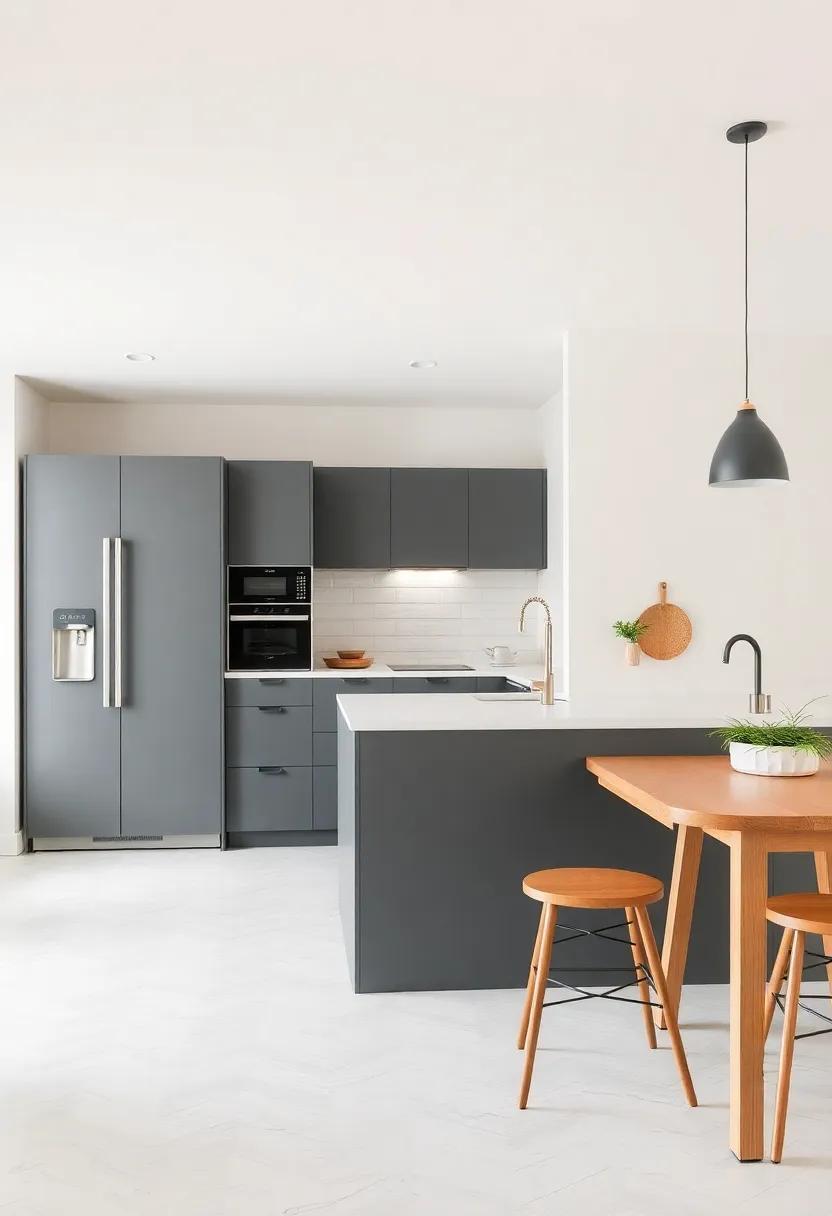
Scandinavian design has made a notable impact on kitchen interiors across the globe,thanks to its commitment to minimalism,functionality,and natural materials. Brands like IKEA, HAY, and Muuto epitomize this ethos, offering products that combine practicality with aesthetic appeal. IKEA’s modular kitchens allow for endless customization,encouraging homeowners to maximize space without compromising style. HAY,on the other hand,brings a fresh twist to kitchen essentials with vibrant colors and smart designs that challenge traditional notions of kitchenware. Simultaneously occurring, Muuto focuses on bringing modern Scandinavian craftsmanship into the kitchen with their beautifully crafted utensils and storage solutions, showcasing how simplicity can enhance everyday life.
Moreover, the influence of Scandinavian brands extends beyond just functionality. They invite us to embrace less clutter and a more serene environment, which is reflected in the choice of colors and textures. The current trends emphasize soft pastels, earthy tones, and sleek finishes, which create a harmonious ambiance. This is perfectly illustrated by brands like Ferm Living and String,which offer elegant yet practical shelving systems and kitchen accessories. Understanding these brands not only provides insight into what drives kitchen design, but also helps in creating spaces that resonate with the Scandinavian philosophy of life—one where simplicity, beauty, and sustainability coexist effortlessly.
Showcasing Culinary Tools: Embracing the beauty of Kitchen Utensils
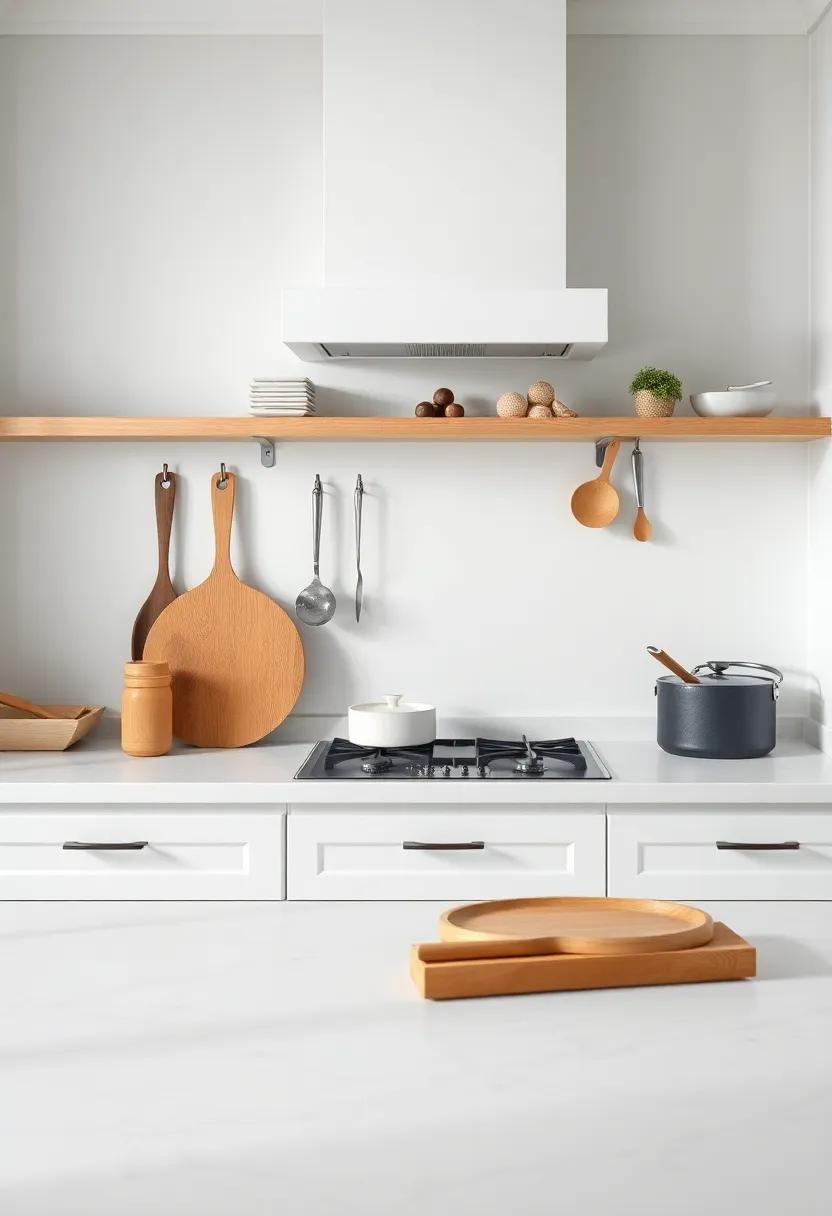
Every kitchen tells a story, and in a Scandinavian-inspired space, the narrative is one of minimalism and functionality. Kitchen utensils and tools become not only essentials but also aesthetics, seamlessly blending form and function. Imagine spoons crafted from beautiful beech wood,their textures inviting touch and use,or ceramic bowls painted in soft neutral tones that evoke tranquil Nordic landscapes. The beauty of these tools lies not just in their appearance but in their craftsmanship, accentuating the importance of quality over quantity in the culinary space. Some essential utensils to consider are:
- Wooden Cooking Spoons: Perfect for stirring and serving, these add warmth to the kitchen.
- cast Iron Skillets: Durable and versatile, a staple in Scandinavian cooking.
- Ceramic Knives: Lightweight and sharp, they provide an elegant cutting experience.
- Stainless Steel Measuring Cups: For precise cooking, merging practicality with sleek design.
Displaying these culinary tools can transform your kitchen into a functional gallery of craftsmanship. Consider a floating shelf or a simple wall-mounted rack to showcase your favorite items, inviting both utility and beauty into the space. You can also create a visual centerpiece by grouping utensils in a rustic terracotta pot or a sleek vase,adding personality to the minimalist backdrop. To inspire a cohesive look, here’s a simple table showcasing some cleanup essentials that align with the scandinavian ethos:
| utensil | Material | Functionality |
|---|---|---|
| Whisk | Stainless Steel | Mixing & Whipping |
| Spatula | silicone | Flipping & Spreading |
| Grater | Stainless Steel | Shredding & Grating |
| Peeler | Plastic & Steel | Peeling Vegetables |
The Conclusion
In a world increasingly adorned with complexity and clutter, the Scandinavian kitchen stands as a beacon of simplicity and functionality. Its clean lines, natural materials, and thoughtful organization invite us to embrace a lifestyle centered around ease and tranquility. As we close the door on this exploration of Scandinavian design, let us carry forward the essence of its philosophy: that beauty lies not in excess, but in the mindful curation of space. By adopting these principles in our own kitchens, we can foster an environment that nurtures creativity, connection, and calm. So, whether you’re redesigning your culinary space or simply seeking inspiration, remember that the allure of a Scandinavian kitchen is not solely in its aesthetic, but in its ability to transform how we experience our daily lives—one simple, elegant moment at a time.

